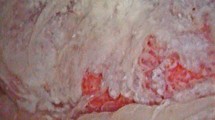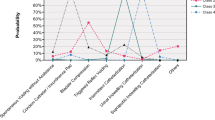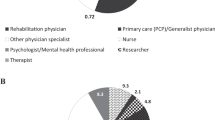Abstract
Study design
Longitudinal study.
Objectives
To describe the severity of spinal cord injury/disease (SCI/D), type and management of neurogenic lower urinary tract dysfunction, tumor characteristics, and bladder cancer latency period in SCI/D patients.
Setting
Spinal cord injury centers in Germany, Austria, and Switzerland.
Methods
Data of SCI/D patients diagnosed with bladder cancer were collected between Jan 2012–Dec 2019 in the course of annual surveys in the neuro-urological departments of all 28 centers. Demographic and paralysis-specific data, data on the type and management of neurogenic lower urinary tract dysfunction, and histopathological tumor characteristics were collected.
Results
Regarding histopathological tumor characteristics, no significant differences were found in 135 individuals with SCI/D when stratified for bladder management without chronic catheterization, SCI/D severity, and ASIA classification.
The mean latency period between the onset of SCI/D and the diagnosis of bladder cancer was significantly longer in patients with catheter-free emptying methods compared to patients with intermittent catheterization, and in patients with LMNL (Lower Motor Neuron Lesion) compared to patients with UMNL (Upper Motor Neuron Lesion).
Conclusions
Urinary bladder carcinomas are late events in the long-term course of SCI/D. Follow-up and approaches to screening must therefore be intensified with increasing duration of long-term SCI.
Similar content being viewed by others
Log in or create a free account to read this content
Gain free access to this article, as well as selected content from this journal and more on nature.com
or
Data availability
The datasets generated during and/or analyzed during this study are available from the corresponding author on reasonable request. An anonymized overview of the data of the patients in this study is given in Suppl. Table 3.
References
Bray F, Ferlay J, Soerjomataram I, Siegel RL, Torre LA, Jemal A. Global cancer statistics 2018: GLOBOCAN estimates of incidence and mortality worldwide for 36 cancers in 185 countries [published correction appears in CA Cancer J Clin. 2020;70:313]. CA Cancer J Clin. 2018;68:394–424.
GBD 2016 Traumatic Brain Injury and Spinal Cord Injury Collaborators. Global, regional, and national burden of traumatic brain injury and spinal cord injury, 1990–2016: a systematic analysis for the Global Burden of Disease Study 2016. Lancet Neurol. 2019:56–87.
Savic G, DeVivo MJ, Frankel HL, Jamous MA, Soni BM, Charlifue S. Causes of death after traumatic spinal cord injury - a 70-year British study. Spinal Cord. 2017;55:891–7.
National Spinal Cord Injury Statistical Center. University of Alabama at Birmingham, 2018 Annual Statistical Report – Complete Public Version. https://www.sci-info-pages.com/wp-content/media/NSCISC-2018-Annual-Report.pdf (Last accessed 15 March 2021).
Gui-Zhong L, Li-Bo M. Bladder cancer in individuals with spinal cord injuries: a meta-analysis. Spinal Cord. 2017;55:341–5.
Ismail S, Karsenty G, Chartier-Kastler E, Cussenot O, Compérat E, Rouprêt M, et al. Prevalence, management, and prognosis of bladder cancer in patients with neurogenic bladder: a systematic review. Neurourol Urodyn. 2018;37:1386–95.
Liu B, Welk B. Urological malignancies in neurogenic patients. Curr Opin Urol. 2020;30:501–6.
Böthig R, Tiburtius C, Fiebag K, Kowald B, Hirschfeld S, Thietje R, et al. Traumatic spinal cord injury confers bladder cancer risk to patients managed without permanent urinary catheterization: lessons from a comparison of clinical data with the national database. World J Urol. 2020;38:2827–34.
Nahm LS, Chen Y, DeVivo MJ, Lloyd LK. Bladder cancer mortality after spinal cord injury over 4 decades. J Urol. 2015;193:1923–8.
Cameron AP, Rodriguez GM, Schomer KG. Systematic review of urological follow-up after spinal cord injury. J Urol. 2012;187:391–7.
Elliott SP. Screening for bladder cancer in individuals with spinal cord injury. J Urol. 2015;193:1880–1.
Kirshblum SC, Burns SP, Biering-Sorensen F, Donovan W, Graves DE, Jha A, et al. International standards for neurological classification of spinal cord injury (revised 2011). J Spinal Cord Med. 2011;34:535–46.
Biering-Sørensen F, DeVivo MJ, Charlifue S, Chen Y, New PW, Noonan V, et al. International spinal cord injury core data set (version 2.0) - including standardization of reporting. Spinal Cord. 2017;55:759–64.
Humphrey PA, Moch H, Cubilla AL, Ulbright TM, Reuter VE. The 2016 WHO classification of tumours of the urinary system and male genital organs - part b: prostate and bladder tumours. Eur Urol. 2016;70:106–19.
Böthig R, Kurze I, Fiebag K, Kaufmann A, Schöps W, Kadhum T, et al. Clinical characteristics of bladder cancer in patients with spinal cord injury: the experience from a single centre. Int Urol Nephrol. 2017;49:983–94.
Ho CH, Sung KC, Lim SW, Liao CH, Liang FW, Wang JJ, et al. Chronic indwelling urinary catheter increase the risk of bladder cancer, even in patients without spinal cord injury. Medicine (Baltimore). 2015;94:e1736.
Hollingsworth JM, Rogers MA, Krein SL, Hickner A, Kuhn L, Cheng A, et al. Determining the noninfectious complications of indwelling urethral catheters: a systematic review and meta-analysis. Ann Intern Med. 2013;159:401–10.
Groah SL, Weitzenkamp DA, Lammertse DP, Whiteneck GG, Lezotte DC, Hamman RF. Excess risk of bladder cancer in spinal cord injury: Evidence for an association between indwelling catheter use and bladder cancer. Arch Phys Med Rehab. 2002;83:346–51.
Vereczkey ZA, Schmeidler J, Binard JE, Bauman WA. Bladder cancer risk in patients with spinal cord injury. J Spinal Cord Med. 1998;21:230–9.
Kalisvaart JF, Katsumi HK, Ronningen LD, Hovey RM. Bladder cancer in spinal cord injury patients. Spinal Cord. 2010;48:257–61.
Böthig R, Golka K, Tiburtius C, Balzer O, Kowald B, Hirschfeld S, et al. Incidental bladder cancer at initial urological workup of spinal cord injury patients. Spinal Cord Ser Cases. 2020;29(6):55.
Alimi Q, Hascoet J, Manunta A, Kammerer-Jacquet SF, Verhoest G, Brochard C, et al. Reliability of urinary cytology and cystoscopy for the screening and diagnosis of bladder cancer in patients with neurogenic bladder: a systematic review. Neurourol Urodyn. 2018;37:916–25.
Blok B (Chair), Castro-Diaz D, Del Popolo G, Groen J, Hamid R, Karsenty G, et al. EAU Guideline Neuro-urology. 2019. https://uroweb.org/guideline/neuro-urology/ (Last accessed 15 March 2021).
Consortium for Spinal Cord Medicine. Bladder management for adults with spinal cord injury: a clinical practice guideline for health-care providers. J Spinal Cord Med. 2006;29(5):527–73.
Author information
Authors and Affiliations
Consortia
Contributions
RB had full access to all the data in the study and takes responsibility for the integrity of the data and the accuracy of the data analysis. Study concept and design: RB, RT, KG. Acquisition of data: RB, KF, OB, CT. Analysis and interpretation of data: RB, BK, KG. Drafting of the manuscript: RB, TK, KG. Critical revision of the manuscript for important intellectual content and proof of the final version: BK, KF, OB, CT, RT, TK, KG. Obtaining funding: None. Statistical analysis: BK, RB. Administrative, technical, or material support: RT. Supervision: RT, TK, KG.
Corresponding author
Ethics declarations
Ethical approval
We certify that all applicable institutional and governmental regulations concerning the ethical use of human volunteers/animals were followed during the course of this research.
Competing interests
The authors declare no competing interests.
Additional information
Publisher’s note Springer Nature remains neutral with regard to jurisdictional claims in published maps and institutional affiliations.
Supplementary information
Rights and permissions
About this article
Cite this article
Böthig, R., Kowald, B., Fiebag, K. et al. Bladder management, severity of injury and period of latency: a descriptive study on 135 patients with spinal cord injury and bladder cancer. Spinal Cord 59, 971–977 (2021). https://doi.org/10.1038/s41393-021-00651-3
Received:
Revised:
Accepted:
Published:
Issue date:
DOI: https://doi.org/10.1038/s41393-021-00651-3
This article is cited by
-
Decision-making algorithm for difficult intermittent self-catheterization: construction and validation using the Delphi method
World Journal of Urology (2025)
-
Neurogene Dysfunktion des unteren Harntraktes bei Rückenmarkverletzung
Die Urologie (2025)
-
Clinical characteristics and molecular mechanisms underlying bladder cancer in individuals with spinal cord injury: a systematic review
BMC Urology (2024)
-
Berufsbedingte Krebserkrankungen in der Urologie – aktuelle Erkenntnisse unter Einbeziehung umweltmedizinischer Aspekte
Journal für Urologie und Urogynäkologie/Österreich (2023)
-
Special surgical aspects of radical cystectomy in spinal cord injury patients with bladder cancer
World Journal of Urology (2022)



